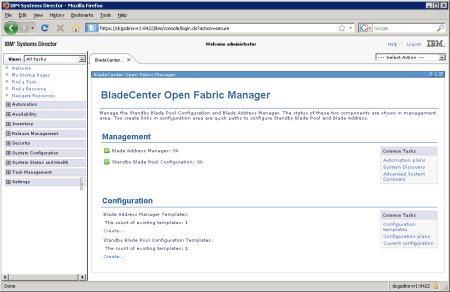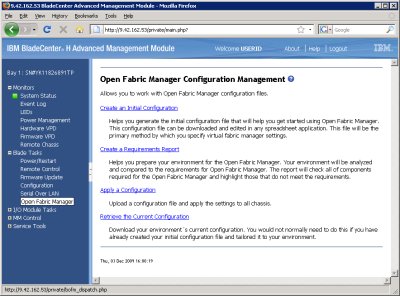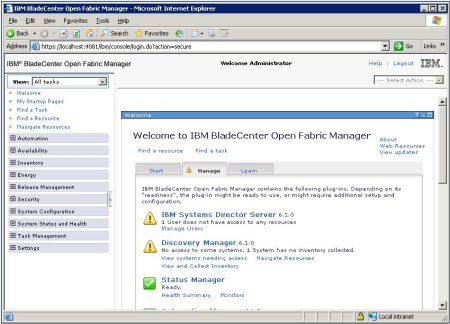Abstract
BladeCenter Open Fabric Manager (BOFM) is a tool for simplifying deployment, failover, and repurposing of blade servers. BOFM performs these tasks by controlling the assignment of physical Ethernet MAC and Fibre Channel WWN addresses for the integrated Ethernet interfaces and I/O expansion cards in each blade.
Withdrawn: This product has been withdrawn from marketing.
Introduction
BladeCenter Open Fabric Manager (BOFM) is a tool for simplifying deployment, failover, and repurposing of blade servers. BOFM performs these tasks by controlling the assignment of physical Ethernet MAC and Fibre Channel WWN addresses for the integrated Ethernet interfaces and I/O expansion cards in each blade.
BOFM provides the ability to create predefined configurations for the external infrastructure connections including network switches, SAN switches, storage systems and so on. With BOFM, you can configure MAC-based VLANs and security policies, WWN-based zones on switches, and storage partitions on storage systems by using your own pool of MAC addresses and WWNs created in advance. You can then assign these predefined addresses to a blade's I/O ports with BOFM instead of using burned-in hardware addresses that were assigned during manufacture.

Figure 1. BladeCenter Open Fabric Manager 3.0 Advanced Upgrade for IBM Director 6.1
Did you know?
It is highly recommended that you plan BOFM together with boot-from-SAN to make the most of the entire solution. BOFM functionality, together with boot-from-SAN techniques, enables you to deploy new blades easily by assigning predefined MAC addresses and WWNs to them and, thus, to connect them to the existing infrastructure in a minutes. You can also repurpose blades quickly by assigning addresses from different services or even provide simplified failover by assigning addresses from a failed blade to the spare blade.
Part number information
There are three different versions of BladeCenter Open Fabric Manager. Table 1 shows the part number to order them.
| Description | Part number | Feature code |
| BladeCenter Open Fabric Manager Basic | 2019B1X | 4941 |
| BladeCenter Open Fabric Manager for BladeCenter S | 2019B2X | 4195 |
| BladeCenter Open Fabric Manager 2.1 Advanced Upgrade (stand-alone utility) | 4812S1X | None |
| BladeCenter Open Fabric Manager 2.1 Advanced Upgrade for IBM Director 5.2 | 4812S1D | None |
| BladeCenter Open Fabric Manager 3.0 Advanced Upgrade (stand-alone utility) | 4812S3X | None |
| BladeCenter Open Fabric Manager 3.0 Advanced Upgrade for IBM Director 6.1 | 4812S3D | None |
Notes:
- One BOFM license is required for each BladeCenter chassis (not for each server)
- Any of the BOFM Advanced Upgrade products requires BOFM Basic or BOFM for BladeCenter S as a prerequisite
Each of the part numbers listed in Table 1 includes a letter explaining how to activate BOFM. BOFM Basic and BOFM for BladeCenter S are part of the advanced management module interface as shown in Figure 2, and other than the latest AMM firmware, no additional BOFM software is needed. The BOFM Advanced Upgrade consists of the activation letter with instructions on how to download the software.
You can download the installation guides using the links in the Related Publications section.
Figure 2 shows the AMM interface of BladeCenter Open Fabric Manager Basic.

Figure 2. BladeCenter Open Fabric Manager Basic
Features
BladeCenter Open Fabric Manager solution consists of the following components:
- BladeCenter Open Fabric Manager Basic (BOFM Basic or BOFM for BladeCenter S)
- BladeCenter Open Fabric Manager Advanced Upgrade
BOFM Basic is the core part of BOFM solution and is integrated into the firmware of the Advanced Management Module of the BladeCenter chassis. BOFM Basic controls address assignments and provides Web-based user interface through AMM. With BOFM Basic, you are able to manually configure address assignments and reassignments.
BOFM Advanced Upgrade is either a stand-alone or IBM Director-based management extension to the user interface that provides IBM Director-style GUI (Java-based for Director 5.2 or Web-based for Director 6.1) and policy-based automated failover capabilities with Event Action Plans.
Table 2 summarizes the management tasks of BOFM Basic and BOFM Advanced Upgrade.
| Management Task | BOFM Basic BOFM for BC-S |
BOFM Advanced Upgrade |
| Slot-based I/O address assignment | Yes | Yes |
| Manages Ethernet MAC addresses, Fibre Channel and SAS WWN numbers | Yes | Yes |
| Supports Fibre Channel and SAS boot targets | Yes | Yes |
| Pre-assignment allows LAN/SAN configuration prior to blade installation | Yes | Yes |
| Automatic re-assignment on blade swap | Yes | Yes |
| Web-based GUI through Advanced Management Module | Yes | No |
| IBM Director-based GUI | No | Yes |
| Blade Address Manager Configuration Wizard | No | Yes |
| Standby Blade Pools | No | Yes |
| Event Action Plans | No | Yes |
| Provides I/O parameter and VLAN migration to standby blades in case of blade failure | No | Yes |
| Number of chassis supported by one BOFM console | 100 | 100 |
| Number of manageable ports per blade | 8 | 8 |
BladeCenter Open Fabric Manager Basic
BOFM Basic is a software upgrade to the Advanced Management Module. It interacts with the BMC or IMM microcode in the blades and the firmware in the I/O expansion cards to replace the burned-in addresses with addresses specified at the blade-bay level by the administrator. BOFM Basic uses the AMM browser-based user interface.
When a blade server is inserted into a specific bay, it inherits hardware addresses for I/O ports that were assigned to this bay by administrator. This enables simplified deployment of blades because you can preconfigure your infrastructure before the physical installation of the blade server into the chassis. In case of blade failure, all you need to do is to replace the failed blade with a new one.
The following solution components must support BOFM for the solution to work properly. These components all need to have firmware levels that supports BOFM.
- Blade servers (BIOS and BMC/IMM)
- Expansion cards
- Advanced management modules in each chassis
BOFM is compatible with most I/O modules because it is not dependent on them. It also uses address reassignment at the blade level rather than at the I/O module level.
With BOFM Basic, you can provide quick deployment and redeployment of blades, and manual slot-based failover or manual blade replacement. To provide automated failover capabilities, the BOFM Advanced Upgrade is required.
BladeCenter Open Fabric Manager for BladeCenter S
BladeCenter Open Fabric Manager for BladeCenter S is based on BOFM Basic, and allows you to reassign the Ethernet MAC addresses and Fibre Channel WWN addresses used by the I/O ports. This version offers a low cost offering designed specifically for small and medium businesses (SMB), as well as distributed and retail clients.
With this offering you can preconfigure the BC-S chassis at a central location and deploy uniformly across your remote locations.
As with BOFM Basic, BOFM for BladeCenter S can be enhanced with BOFM Advanced Upgrade.
BladeCenter Open Fabric Manager Advanced Upgrade
BOFM Advanced Upgrade adds capabilities for managing address assignments through the IBM Systems Director user interface and policy-based automated failover. With this upgrade, you can define failover pools of spare blades across chassis and failover rules with Event Action Plans. BOFM Basic uses the advanced management module's Web interface for configuration tasks. However, BOFM Advanced Upgrade uses a separate IBM Director-based GUI (for both IBM Director and stand-alone editions).
BOFM Advanced Upgrade is available in two editions:
- Stand-alone utility
- BladeCenter Open Fabric Manager 2.1 Advanced Upgrade, part number 4812S1X
- BladeCenter Open Fabric Manager 3.0 Advanced Upgrade, part number 4812S3X
- IBM Systems Director extension
- BladeCenter Open Fabric Manager 2.1 Advanced Upgrade, part number 4812S1D
- BladeCenter Open Fabric Manager 3.0 Advanced Upgrade, part number 4812S3D
BOFM 2.1 Advanced Upgrade is based on the IBM Director 5.2 core and user interface and is a Java application. You use BOFM 2.1 Advanced Upgrade if you are currently running IBM Director 5.2, including both the stand-alone and Director extension. BOFM 3.0 Advanced Upgrade is based on the IBM Systems Director 6.1 core and user interface and is a Web interface. You use BOFM 3.0 Advanced Upgrade if you have an IBM Systems Director 6.1 infrastructure in place.
You need to install the Stand-alone utility on a separate management workstation. You install the IBM Systems Director extension on an existing IBM Systems Director management server. We list the supported operating systems later.
The BOFM 3.0 Advanced Upgrade adds the following features compared to BOFM 2.1 Advanced Upgrade:
- Web-based user interface (based on IBM Systems Director 6.1)
- New Wizards:
- Blade Address Manager Configuration Template Wizard
- Standby Blade Pool Configuration Template Wizard
- CSV configuration file import/export
- Support for evaluation and permanent license keys
- Support for SAS cards and I/O modules
- Support for CIOv cards
- Support for HS22 and JS23/43
Figure 3 shows the stand-alone version of BOFM Advanced Upgrade 3.0

Figure 3. BladeCenter Open Fabric Manager Advanced Upgrade 3.0 (stand-alone version)
For more information, go to the BOFM product Web page:
http://www.ibm.com/systems/bladecenter/hardware/openfabric/openfabricmanager.html
Supported hardware
The following tables lists chassis, servers, and options that support the various BOFM part numbers.
| BladeCenter E | 8677 | Y | N | Y | Y | Y | Y |
| BladeCenter H | 8852 | Y | N | Y | Y | Y | Y |
| BladeCenter S | 8886 | Y | Y | Y | Y | Y | Y |
| BladeCenter T | 8720, 8730 | Y | N | Y | Y | Y | Y |
| BladeCenter HT | 8740, 8750 | Y | N | Y | Y | Y | Y |
| BladeCenter QS22 | 0793 | Y | N | Y | Y | Y | Y |
| BladeCenter JS23/JS43 | 7778 | Y | Y | N | N | Y | Y |
| BladeCenter HS22 | 7870 | Y | Y | N | N | Y | Y |
| BladeCenter LS22 | 7901 | Y | Y | Y | Y | Y | Y |
| BladeCenter LS42 | 7902 | Y | Y | Y | Y | Y | Y |
| BladeCenter LS21 | 7971 | Y | Y | Y | Y | Y | Y |
| BladeCenter LS41 | 7972 | Y | Y | Y | Y | Y | Y |
| BladeCenter HS21 XM | 7995 | Y | Y | Y | Y | Y | Y |
| BladeCenter JS12 | 7998-60X | Y | Y | Y | Y | Y | Y |
| BladeCenter JS22 | 7998 | Y | Y | Y | Y | Y | Y |
| BladeCenter HS12 | 8014, 8028 | Y | Y | Y | Y | Y | Y |
| BladeCenter HS21 | 8853 | Y | Y | Y | Y | Y | Y |
| Integrated Gigabit Ethernet | None | Y | Y | Y | Y | Y | Y |
| QLogic 2-port 10Gb CNA (CFFh) | 42C1830 | Y | N | N | N | Y | Y |
| SFF Gigabit Ethernet Expansion Card | 39R8624 | Y | Y | Y | Y | Y | Y |
| NetXen 10 Gb Ethernet (CFFh) | 39Y9271 | Y | N | Y | Y | Y | Y |
| Ethernet Expansion Card (CFFv) | 39Y9310 | Y | Y | Y | Y | Y | Y |
| Ethernet Expansion Card (CIOv) | 44W4475 | Y | Y | N | N | Y | Y |
| 2/4 Port Ethernet Expansion Card (CFFh) | 44W4479 | Y | Y | Y | Y | Y | Y |
| QLogic Ethernet & 4Gb FC (CFFh) | 39Y9306 | Y | N | Y | Y | Y | Y |
| QLogic Ethernet & 8Gb FC (CFFh) | 44X1940 | Y | N | N | N | Y | Y |
| Broadcom 10Gb 4-port Ethernet (CFFh) | 44W4465 | Y | N | Y | Y | Y | Y |
| Broadcom 10Gb 2-port Ethernet (CFFh) | 44W4466 | Y | N | Y | Y | Y | Y |
| Broadcom 10Gb Gen 2 4-port Ethernet (CFFh) | 46M6164 | N | N | N | N | N | N |
| Broadcom 10Gb Gen 2 2-port Ethernet (CFFh) | 46M6168 | N | N | N | N | N | N |
| Emulex Virtual Fabric Adapter (CFFh) | 49Y4235 | Y | N | N | N | Y | Y |
| Fibre Channel Expansion Cards | |||||||
| QLogic 4Gb StFF FC Expansion Card | 26R0884 | Y | Y | Y | Y | Y | Y |
| QLogic 4Gb SFF FC Expansion Card | 26R0890 | Y | Y | Y | Y | Y | Y |
| Emulex 4Gb SFF FC Expansion Card | 39Y9186 | Y | Y | Y | Y | Y | Y |
| QLogic Ethernet and 4Gb FC (CFFh) | 39Y9306 | Y | N | Y | Y | Y | Y |
| QLogic 4Gb Fibre Channel (CFFv) | 41Y8527 | Y | Y | Y | Y | Y | Y |
| Emulex 4Gb Fibre Channel (CFFv) | 43W6859 | Y | Y | Y | Y | Y | Y |
| QLogic Ethernet & 8Gb FC (CFFh) | 44X1940 | Y | N | N | N | Y | Y |
| QLogic 8Gb Fibre Channel (CIOv) | 44X1945 | Y | Y | N | N | Y | Y |
| QLogic 4Gb Fibre Channel (CIOv) | 46M6065 | Y | Y | N | N | Y | Y |
| Emulex 8Gb Fibre Channel (CIOv) | 46M6140 | Y | Y | N | N | Y | Y |
| SAS Expansion Cards | |||||||
| SAS Expansion Card (CFFv) | 39Y9190 | Y | Y | N | N | Y | Y |
| SAS Connectivity Card (CFFv) | 43W3974 | Y | Y | N | N | Y | Y |
| SAS Connectivity Card (CIOv) | 43W4068 | Y | Y | N | N | Y | Y |
| ServeRAID MR10ie (CIOv) | 46C7167 | N | N | N | N | N | N |
Notes:
- Any I/O module that is compatible with the chassis and expansion card can be used with BOFM.
- The following blade servers are not supported by BOFM:
- HS20 (8678, 8832, 7981, 8843)
- HS40 (8839)
- LS20 (8850)
- HC10 (7996)
- JS20 (8842)
- JS21 (7988)
- QS20 (0200)
- QS21 (0792)
- PN41 (3020)
- InfiniBand adapters and I/O modules are not supported by BOFM.
Supported operating systems
BOFM Basic and BOFM for BladeCenter S are operating system independent.
BOFM 2.1 Advanced Upgrade is supported with the following operating systems:
- Microsoft Windows 2003 (SP1, SP2, R2)
- Microsoft Windows 2000 (Up to SP4)
- RHEL 3 (up to SP9)
- RHEL 4 (up to SP6)
- RHEL 5 with Xen 3.0 (up to SP1)
- SLES 9 (up to SP4)
- SLES 10 with Xen 3.0 (up to SP1)
BOFM 3.0 Advanced Upgrade is supported with the following operating systems:
- Microsoft Windows 2008 (SP1, SP2)
- Microsoft Windows 2003 (SP1, SP2, R2)
- RHEL 4 (up to SP8)
- RHEL 5 (up to SP4)
- SLES 9 (up to SP4)
- SLES 10 (up to SP2)
Related product families
Product families related to this document are the following:
Trademarks
Lenovo and the Lenovo logo are trademarks or registered trademarks of Lenovo in the United States, other countries, or both. A current list of Lenovo trademarks is available on the Web at https://www.lenovo.com/us/en/legal/copytrade/.
The following terms are trademarks of Lenovo in the United States, other countries, or both:
Lenovo®
BladeCenter®
The following terms are trademarks of other companies:
Microsoft® and Windows® are trademarks of Microsoft Corporation in the United States, other countries, or both.
IBM® and ibm.com® are trademarks of IBM in the United States, other countries, or both.
Other company, product, or service names may be trademarks or service marks of others.
